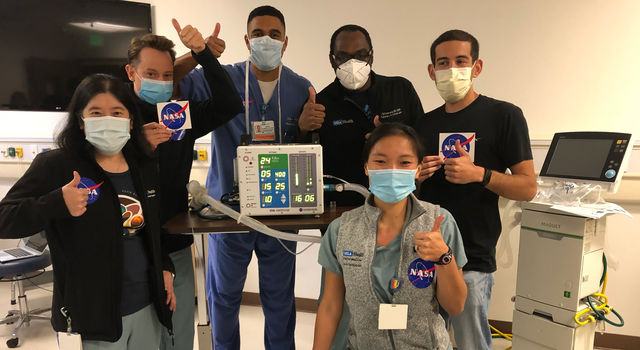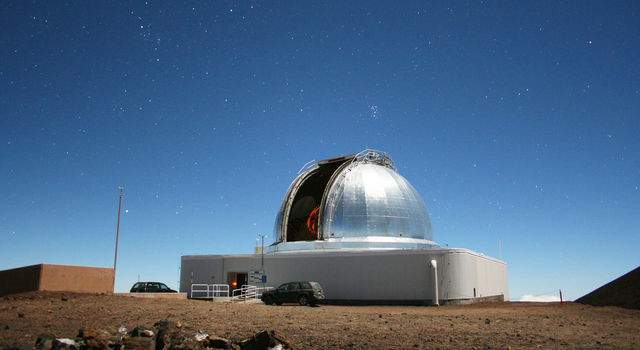Blogs | JPL | April 23, 2009
Good and Bad Ozone
Oxygen, or O2 on the table of chemical elements, is a vital component for life on Earth. It is the second most abundant gas in Earth's atmosphere, making up about 21 percent of its volume. On the other hand, its cousin ozone (O3) makes up less than 0.00001 percent. In fact, if all the ozone in Earth's atmosphere were brought down to the surface, air pressure and temperature conditions would compress ozone into a layer just three millimeters thick, equivalent to two pennies stacked one on top of the other. ! Despite its tiny amount, ozone is also a vital ingredient for life on Earth.
Ozone in fact is vital for life on Earth, but it also has a "bad" side as well - that is, there is both good and bad ozone out there. Good ozone, which accounts for about 91 percent of the ozone in Earth's atmosphere, is present in the stratosphere, the middle layer in Earth's atmosphere. This portion of ozone is commonly referred to as the "ozone layer." The ozone layer absorbs more than 90 percent of the sun's high-frequency ultraviolet light, which is potentially damaging to life on Earth. Without the ozone layer, this radiation would not be filtered as it reaches the surface of Earth, resulting in detrimental health effects for life on Earth. Among the health effects humans could experience as a result of overexposure to ultraviolet radiation are skin cancers, premature aging of the skin and other skin problems, cataracts and other forms of eye damage, and suppression of our bodies' immune systems and our skin's natural defenses.
The troposphere, the part of the atmosphere closest to Earth, contains both good and bad ozone. In the lower troposphere, ozone may serve as an air pollutant since it is a major component of photochemical smog. In the middle troposphere, ozone acts as an atmospheric cleanser, and in the upper troposphere, ozone is a greenhouse gas, which could be bad if concentrations get too high.
The Tropospheric Emission Spectrometer, a science instrument onboard NASA's Aura satellite, is improving our understanding of the good and bad ozone in the troposphere. The spectrometer, which was launched in 2004, provides the first global view of tropospheric ozone and vertical concentrations of ozone, as well as temperature and other important tropospheric features, including carbon monoxide (CO), methane (CH4), water vapor and ammonia (NH3). The instrument has studied the origin and distribution of tropospheric ozone. It has also shed light on how the increasing ozone abundance in the troposphere is affecting air quality on a global scale, as well as ozone's role in chemical reactions that "clean" the atmosphere, and climate change.
These data are used by scientists to determine the degree to which natural sources, like lightning and plant growth, and human-produced sources, like automobiles, industrial pollution, and biomass burning, contribute to ozone production and chemistry. For example, during summertime in the upper troposphere, where ozone acts as a greenhouse gas, lightning generates much greater amounts of ozone than do human activities, thereby having a big impact on regional pollution. Over the last few years, the spectrometer has obtained global data on ozone and chemicals that participate in ozone formation. The fact that the instrument is able to quantify vertical profiles of ozone improves our understanding of how various reactions taking place at specified heights contribute to ozone chemistry. Similar to ozone, chemicals that participate in its production also exist in tiny amounts. Still, this enables scientists to better understand long-term variations in the quantity, distribution and mixing of many tropospheric gases that have a large impact on climate and air quality.
My role with the instrument is to validate the quality of the most recent ozone measurements, which are taken in a special observation mode, called "stare." This mode is used to monitor biomass burning events and volcanic activity. I compare measurements taken by an ozonesdone (a lightweight, balloon-borne instrument that measures ozone, air pressure, temperature and humidity as it ascends through the atmosphere) with measurements from the tropospheric spectrometer. We do this so we can demonstrate the accuracy and precision of the instrument's readings. I am also participating in projects that use the instrument data to better understand the chemistry and transport of pollutants coming from wildfires, such as those that occurred in Australia in December 2006. For the future, I am interested in using the tropospheric spectrometer satellite data for ozone and methane to better quantify the degree to which they contribute to global warming and climate change.
TAGS:EARTH, OZONE, TROPOSPHERE, AURA, TROPOSPHERIC EMISSION SPECTROMETER







